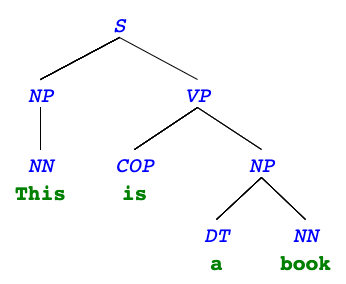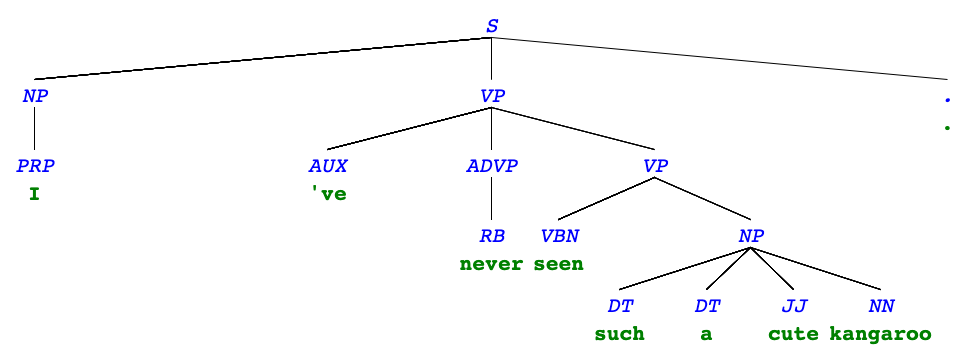Syntax
- Press O or Escape for overview mode.
- Visit this link for a nice printable version
- Press the copy icon on the upper right of code blocks to copy the code
Class outline:
- Syntax trees
- Data abstractions
- Parsing syntax trees
- Sentence generation
Syntax trees
Syntax trees
Both programming languages and spoken languages can be parsed into syntax trees.
For a spoken language, a syntax tree reveals the syntactic structure of a single sentence.
"This is a book"

Syntax tree terminals
The leaves are also called terminals: they contain both a syntactic identifer (tag) and the actual world.

- NN: singular noun (e.g. "This", "book")
- COP: copula (e.g. "is")
- DT: determiner (e.g. "the")
Other terminals: NNS (plural noun), NNP (proper noun), PRP (personal pronoun), JJ (adjective), IN (preposition), CC (coordinating conjunction), AUX (auxillary verb), RB (adverb), VBN (verb, past participle), ...
Syntax tree non-terminals
The other nodes are called non-terminals and contain only tags (typically a phrase type). The tag describes the phrase in the leaves under them.

- S: sentence (e.g. "This is a book")
- NP: noun phrase (e.g. "This", "a book")
- VP: verb phrase (e.g. "is a book")
Other non-terminals: SQ (question), PP (prepositional phrase), ADVP (adverb phrase)...
More syntax trees
"Is that a big bug or a little bug?"

More syntax trees
"I've never seen such a cute kangaroo."

Syntax tree representation
Using the tree abstraction

The label of non-terminals will be just the tag: "S", "NP", "VP".
The label of terminals will be a list of the tag and the word itself:
["NN", "This"], ["COP", "is"], ["DT", "a"], ["NN", "book"].
A tree() version

t = tree("S", [
tree("NP", [tree(["NN", "this"])]),
tree("VP", [
tree(["COP", "is"]),
tree("NP", [
tree(["DT", "a"]),
tree(["NN", "book"])
])
])
])
Additional abstractions
def phrase(tag, branches):
return tree(tag, branches)
def word(tag, text):
return tree([tag, text])
def text(word):
return label(word)[1]
def tag(t):
"""Return the tag of a phrase or word."""
if is_leaf(t):
return label(t)[0]
else:
return label(t)
Parsing
Parsing files into trees
Input data: suppes.parsed
(ROOT (S (NP (NN this)) (VP (COP is) (NP (DT a) (NN book))) (. .)))
(ROOT (S (NP (PRP I))
(VP (AUX 've)
(ADVP (RB never))
(VP (VBN seen) (NP (DT such) (DT a) (JJ cute) (NN kangaroo))))
(. .)))
Desired output: tree()s!
File comes from:
MacWhinney, B. (2000). The CHILDES Project: Tools for analyzing talk. Third Edition. Mahwah, NJ: Lawrence Erlbaum Associates.
Reading files in Python
Here are two ways to read a plain text file.
Get one string containing the whole contents of the file:
open('/some/file.txt').read()
A list of strings, each containing one line:
open('/some/file.txt').readlines()
Using readlines() on the input file:
open('suppes.parsed').readlines()
Useful string methods
str.strip() returns a string without whitespace (spaces, tabs, etc.) on the ends
' hello '.strip() # 'hello'
str.split(sep=None) returns a list of strings that were separated by sep
'hi there '.split() # ['hi', 'there']
str.replace(a, b) returns a string with all instances of string a replaced by string b
'2+2'.replace('+', ' + ') # '2 + 2'
From lines to tokens
['(ROOT (S (NP (NN this)) (VP (COP is) (NP (DT a) (NN book))) (. ?)))\n',
'\n',..
[['(', 'ROOT', '(', 'S', '(', 'NP', '(', 'NN', 'this', ')', ')',
'(', 'VP', '(', 'COP', 'is', ')', '(', 'NP', '(', 'DT', 'a', ')',
'(', 'NN', 'book', ')', ')', ')', '(', '.', '?', ')', ')', ')'],
...]
read_sentences takes care of this:
lines = open('suppes.parsed').readlines()
tokens = read_sentences(lines)
From tokens to to trees
[..., '(', 'NP', '(', 'DT', 'a', ')', '(', 'JJ', 'big', ')', '(', 'NN', 'bug', ')', ')', ...]
# i
def read_parse_tree(tokens, i):
# Read the tag, which is tokens[i], then advance i.
# While the current item is a '(',
# call read_parse_tree to construct a branch.
# Once the current item is a ')',
# return a phrase from the tag and branches.
# Base case: there is no '(' or ')'
# because there is just text after the tag.
read_parse_tree will return the tree it read and what to read next.
tree = read_parse_tree(tokens[0], 1)
Generating sentences
Language models
A statistical (or probabilistic) language model describes how likely some text would be.
What word do you think appears at the end of this ____?
Sampling from a statistical language model uses that description to generate language.
A useful language model needs to generalize from examples.
E.g., Substitute any phrase in an utterance with any other phrase that has the same tag.
- (S (NP (DT the) (NN dog)) (VP (VBD ran)))
- (S (NP (DT the) (NN water)) (VP (VBD evaporated)))
Possible trees per tag
First we need to know all the possible substitutes for a given tag.
def index_trees(trees):
"""Return a dictionary from tags to lists of trees."""
index = {}
for t in trees:
for tag, node in nodes(t):
if tag not in index:
index[tag] = []
index[tag].append(node)
return index
trees = [tokens_to_parse_tree(s) for s in all_sentences()]
tree_index = index_trees(trees)
Generating new trees
Then we need a sampling strategy:
- Starting with the branches of the root node, flip a coin for each branch.
- If it comes up heads, swap that branch for another branch (phrase or word) that has the same tag.
- Then, apply this procedure to all of the branches.
def gen_tree(t, tree_index, flip):
"""Return a version of t in which branches are randomly replaced."""
new_branches = []
if is_leaf(t):
return t
for b in branches(t):
if flip():
b = random.choice(tree_index[tag(b)])
new_branches.append(gen_tree(b, tree_index, flip))
return phrase(tag(t), new_branches)
Python Project of The Day!
Natural Language Toolkit
NLTK: An open-source Python library for language modeling, spelling correction, text classification, sentiment analysis, information retrieval, relation extraction, recommendation systems, translation question answering, word vectors, and more.

Further learning: Github repo, NLTK Book, NLTK Sentiment Analysis